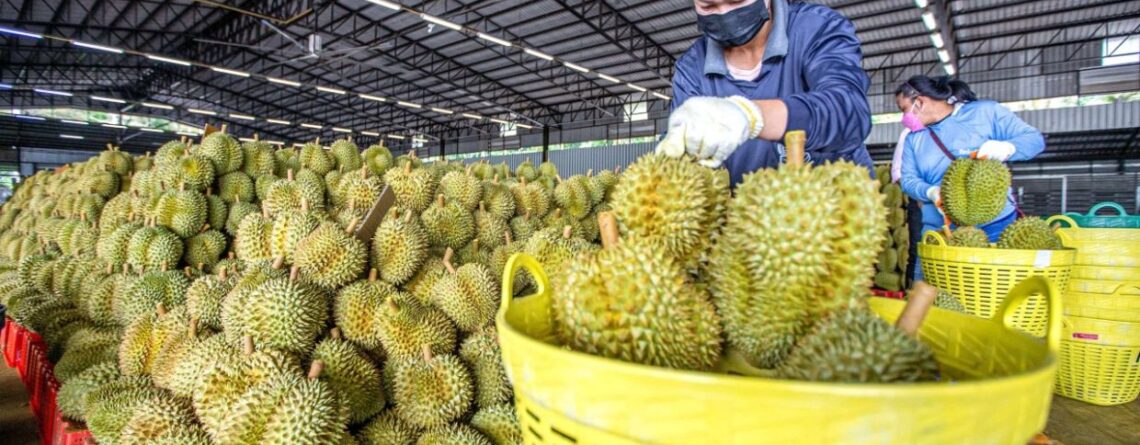China’s first durian sales just days away after month-long delay due to weather
China’s home-grown durians are poised to hit the market in a matter of days, but their limited yields and high prices are not expected to challenge the market share of Southeast Asian importers until large-scale commercial cultivation can be realised, according to state media.
On the southern tropical island of Hainan, the domestically produced durians have been ripening and are primed for their first sales in the market, Xinhua reported on Wednesday.
The initial durian harvest is said to span 93.3 hectares (230.6 acres) of flowering plots in the province, but planter Youqi Agricultural Group is cultivating a total of 800 hectares that should support increased yields in the coming years, according to the report.
Do you have questions about the biggest topics and trends from around the world? Get the answers with SCMP Knowledge, our new platform of curated content with explainers, FAQs, analyses and infographics brought to you by our award-winning team.
They are priced at 120 yuan (US$16.80) per kilogram, or about three times the cost of the vast majority of imported durians, according to the “Produce Report” published by Shanghai-based MZ Marketing Communications on Tuesday.
Can China bring down local durian prices as it reaps first large-scale harvest?
“The price of domestically produced durians won’t go down in the short term, and China will still be dependent on the Southeast Asian market to meet its durian demand,” said Feng Xuejie, director of the Institute of Tropical Fruit Trees at the Hainan Academy of Agricultural Sciences.
As the world’s largest durian consumer market, China imported 825,000 tonnes of the fruit in 2022, according to the General Administration of Customs.
Feng, also a researcher with the Hainan Academy of Agricultural Sciences, told the Post that due to weather changes in Hainan, the harvest has been delayed about a month, as the first batch was expected to hit the market in June.
“The domestic durians produced this time are very limited. They are now available only in the orchards, but their production will go up annually in the future,” Feng said, adding that domestic durians focus more on flavour and quality but are unable to compete with Southeast Asian countries in terms of price.
“I think the biggest difficulty for Hainan and the whole of East Asia to grow durian is the constant typhoons,” Feng said at a seed conference in Hainan in early April.
The fragile trunk of a durian tree makes it difficult to withstand high winds, and a sort of metal “shelf” installed to collect fallen durian can cost 1,000 yuan per tree, according to Feng.
“There’s still a question as to whether this shelf can survive a typhoon,” Feng said, adding that the lack of durian-planting experience among most farmers is also an obstacle to China’s large-scale commercial planting.
China’s domestic durian cultivation is mostly carried out by private companies, which rely heavily on imported durian seedlings, while seed quality is difficult to judge by appearance, and the lack of sufficient land and mother trees is hindering large-scale durian planting in the country, Feng added.
China to eat first local durians in June. Is Malaysian, Thai dominance at risk?
“Seedling introduction is a time-consuming and labour-intensive work that is mainly undertaken by private enterprises,” he said, adding that the government “needs to provide greater support to these companies”.
China’s fresh durian imports in the first three months of this year totalled 91,400 tonnes, and the value of imports was US$507 million – figures that were up 154.29 per cent and 124.62 per cent, respectively, compared with the same period last year, customs data shows.
China’s durian imports are highly dependent on Southeast Asian countries, including Thailand, Vietnam and Malaysia.
In the first quarter of this year, Vietnam exported US$153 million worth of durians – 7.3 times more than a year prior. And China accounted for 87 per cent of that total, according to data from the Ministry of Commerce.
More from South China Morning Post:
- China’s durian appetite grows as the now fashionable ‘king of fruits’ becomes a costly status symbol
- Blackpink in Vietnam, Fukushima water release, China’s demand for durian: SCMP’s 7 highlights of the week
- Singaporeans gobble up dirt cheap Malaysian durians as prices crash amid plentiful harvest
- China’s love of durian brought the Southeast Asian fruit to Hainan, but food flowed the other way in the past – take Hainanese chicken rice
- China’s Vietnamese durian imports seen pushing total demand for fruit to nearly 1 million tonnes a year
For the latest news from the South China Morning Post download our mobile app. Copyright 2023.













Leave a Reply